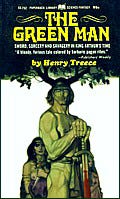The Green Man is a primal archetype. He represents man’s link with untamed, fecund nature, the seasons, and the cycle of birth, regeneration and death. Treece takes this mythic symbol and weaves his tragic hero, Amleth, the Green Man of Vendilsgarth, into a dark, haunting story as old as time, a story of bitter sibling rivalry, covetous lust, incest, murder and vengeance. Set in sixth-century Denmark, this is a very different version of the tale made famous by Shakespeare’s play “Hamlet”.
When Feng murders his brother, King Vendil of Jutland and usurps his throne, he commits not only fratricide but also sacrilege. The Jutlanders venerate the numinous forces of the natural world, placating them with primeval rituals of blood and sex. Their king and queen embody the divine powers of the King of the Wood and the Barley Queen. The forest itself chooses Vendil’s warrior son Amleth as king, proving false the claim of his kin-slaying uncle. But with the collusion of King Beowulf of the Geats, Feng sends Amleth to a pre-arranged death in Britain at the hands of Duke Arthur the Bear. Meanwhile, Amleth and his fearsome mother, Queen Gerutha, vow blood-feud against Feng.
Despite faint gleams of ancient grandeur, Amleth’s world is dark and savage. Men alleviate its harshness by rutting, drinking, and boasting about their own deeds and those of their heroes. Their boasting glorifies a less than heroic reality. Beowulf is a lethal, amoral pirate, and Duke Arthur balding, arthritic and ruthlessly pragmatic. Men smile with bared teeth and hand on sword; violence and treachery lie close behind affable welcome. Surrounded by predators, Amleth appears to lead a charmed life, but the Green Man is also the King of the Year. For spring to follow winter, the King must die when his task is done, his sacrifice surety for the renewal of life. This magnificently somber drama can have no happy ending. (1966, 253 pages)



